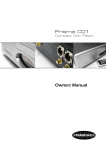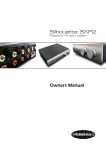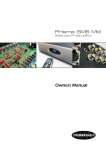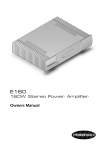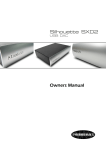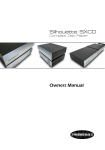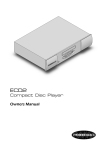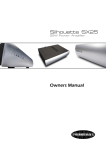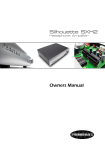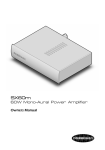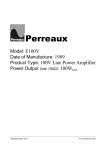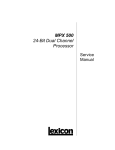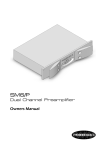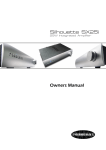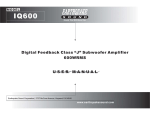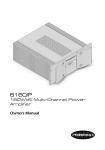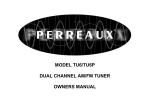Download Perreaux Prisma 350 User's Manual
Transcript
Prisma 350 Stereo Power Amplifier Owners Manual Perreaux Industries Limited makes no warranty for the use of its products, other than those expressly contained in the warranty detailed herein. The Company assumes no responsibility for any errors which may appear in this document, reserves the right to change products or specifications detailed herein at any time without notice, and does not make any commitment to update the information contained herein. No licenses to patents or other intellectual property of Perreaux are granted by the Company in connection with the sale of Perreaux products, expressly or by implication. mboob^ru® is a registered trademark of Perreaux Industries Ltd. Terms and product names in this document may be trademarks of others. 2 i Introducing the Perreaux 350 Power Amplifier Congratulations on your Perreaux 350 purchase. To realise the full potential of your unit you need to appreciate all aspects of its operation. Before installing the 350 into your system, read the entire manual carefully. Endeavour to understand every detail by familiarising yourself with the controls and features as you read. You will find it easier to install using the relevant sections of this manual as a reference. We have attempted to explain every feature and operational facet clearly and concisely. In the event that something is still unclear to you, your Perreaux dealer will be happy to assist you further. Read this manual, install your unit correctly and realise the sonic significance of your investment in Perreaux. Perreaux products are designed to provide the utmost in sonic realism and electronic reliability with a functional yet elegant appearance that reflects the care and craftsmanship applied during all stages of construction. Features at a Glance Balanced and Unbalanced inputs Rugged build quality Ultra-stiff power supply Soft-Start circuit Hybrid Class A/AB output stages MOSFET output devices High power output Dual binding posts per channel Remote trigger input and output M ultiple protection systems Advanced PCB design and earthing techniques Earth isolation switch To maintain the consistently high quality that you expect from us, and we expect from ourselves, Perreaux products are essentially handcrafted. We maintain the human-link throughout, from design and construction, through to the ultimate test, your music, your system, your ears. Because we too listen to our products, we know that with your Perreaux you will discover many more of the musical secrets we strive to reveal. From all of us at Perreaux Industries Limited, thank you for choosing the Perreaux Prisma Series 350 power amplifier. 3 ii Important Safety Instructions Note: All safety and operation instructions should be read carefully before the 350 is operated. Keep the Owners Manual in a safe place for future reference. The 350 should not be used near water, for example near a bathtub, kitchen sink, in a wet basement, near a swimming pool, etc. M ounting to a wall or ceiling should be via a heavy-duty bracket or shelf designed for audio equipment use. The 350 should be situated away from heat sources such as radiators, stoves, or other appliances that produce excessive amounts of heat. Always ensure the 350 heat sinks have adequate ventilation enabling air circulation both above and below. DO NOT place the 350 directly onto carpeted surfaces. Avoid exposing the 350 to extremely high or low temperatures. The 350 should be connected to a mains power supply only of the type described in the operating instructions, or as marked on the rear of the unit. DO NOT disconnect the mains earth from the system. The mains power supply cord should be routed so that it is not likely to be walked on or pinched by items placed on or against it. The power cord of the 350 should be unplugged from the mains outlet when the unit is to be left unused for long periods or when attempting to connect or disconnect cables and before cleaning your unit. Care should be taken so that objects and/or liquids do not accidentally fall inside the 350. Please keep electrical equipment out of reach of children. Please unplug sensitive electronic equipment during electrical storms. Please replace any fuse with the value and type specified. Avoid operating the 350 with the cover removed. DO NOT bypass any fuse. 4 DO NOT attempt to repair the 350. In the event of a problem, please contact your Perreaux dealer. DO NOT operate this product in an explosive atmosphere. Caution! The 350 is an extremely high powered, convection cooled amplifier. The finned outer heat sinks may become very hot when delivering high volume levels – to avoid injury; care should be taken not to touch the heat sinks during operation. 5 iii Table of Contents i ii iii 1 2 3 4 5 6 7 8 9 10 11 12 13 14 15 Introducing the Perreaux 350 Power Amplifier ........................................................3 Important Safety Instructions ........................................................................................4 Table of Contents ..............................................................................................................6 Unpacking and Placement..............................................................................................7 Instant Install......................................................................................................................9 Front Panel Functions................................................................................................... 11 Rear Panel Functions..................................................................................................... 12 Special Design Philosophies ........................................................................................ 16 Special Design Features................................................................................................ 18 Maximising System Potential ...................................................................................... 20 The Power MOSFET....................................................................................................... 22 Care and Maintainance ................................................................................................ 25 Warranty Information and Obtaining Service........................................................ 26 Extended Warranty Registration Form .................................................................... 27 Faultfinding Your System ............................................................................................. 28 Specifications................................................................................................................... 33 Physical Dimensions ...................................................................................................... 36 Contact Details................................................................................................................ 37 6 1 Unpacking and Placement The 350 is packaged for maximum protection. Please carefully read the instructions below before proceeding to unpack the unit. Be extremely careful. Unpacking Procedure Note: Inspect both ends of the cardboard box and open at the end without the central staple by slitting the reinforced tape at either side. Fold back the flaps and tip the package on end and the inner box will slide out. Lay the inner box down flat and upright, open it conventionally by separating the top tray from the bottom. The product can now be removed from the bottom packaging. This will be easier if you have someone to help you by holding the base of the box. Alternately, the bottom tray and amplifier could be tipped upside down and the bottom packaging removed. If opened in this manner, please ensure that you turn the contents over again. Be very careful to secure the unit if you are planning to flip the package upside down. Remove the two white polystyrene protectors off either side of the amplifier, leaving the black material covering. Pull back the material and remove the protective black tissue from the front panel. The amplifier is now unpacked and ready for further installation. Note: Please retain all packaging material for future transport. Box Contents 1 x 350 Power amplifier 1 x 350 Product manual 1 x Detachable AC power cord 3 x Performance analysis charts Placing Your 350 The 350 should generally be placed close to your preamplifier, keeping the interconnect cabling short. We strongly recommend keeping the 350 on it’s own separate shelf to allow for proper ventilation. 7 Ventilation Requirements Note: The 350 is a high-powered amplifier. For optimal performance, the unit M UST receive adequate ventilation. Please do not install in a sealed cabinet. Please do not stack products directly on top of the unit. Please do not cover the product with a cloth or similar. Please do not mount the 350 directly onto carpeted surfaces. As a “rule of thumb”, allow 80-100mm (3-4 inches) around all sides of the product and mount the 350 on a flat surface, ensuring that the unit has adequate access to free flowing air. In the event that the 350 is to be incorporated into custom cabinetry, please refer to Chapter 14 “Physical Dimensions”. Please take all necessary steps to ensure that the unit receives adequate ventilation 8 2 Instant Install If you are like us, the first thing you will want to do is to play your favourite piece of music through your new 350. The following instructions are written to enable you to achieve this as quickly as possible. These are not comprehensive instructions, but are designed to enable you to play music now! Note: Please take the time to read the 350 manual thoroughly as it incorporates many features, which will enhance its operation. Placement The 350 is a high-power amplifier and best results will be achieved when placed on a solid surface with adequate ventilation. DO NOT place on a carpeted floor or cover the amplifier! Turn off associated components This minimises the potential to damage any other components when connecting your 350 into the system. Connect preamplifier to 350 Connect the output of your preamplifier to either the balanced (XLR) or unbalanced (RCA) inputs at the rear of the 350 and set the input configuration toggle switch at the rear to the correct position. Note: Try to keep all interconnect cables as far from loudspeaker cabl es as possible and well away from all AC mains leads. Connect speaker cables to the left and right speaker terminals We recommend using high quality connectors for your speaker cables, spade lugs are the preferable option as they combine a larger surface area with the possibility of a strong mechanical connection; however, high quality banana terminals are also acceptable. Note: Be careful to maintain channel integrity, i.e. left to left, right to right, and phase integrity, positive (+) to positive (+), negative (-) to negative (-). Switch on preamplifier Turn on the preamplifier and set the volume to the minimum level. Select the respective input to which your source component is connected. Switch on 350 After checking the supply voltage compatibility with the voltage rating on the 350 rear panel, insert the power cord-set supplied into the rear of the unit and into the wall. Switch on the socket at the wall and power up the 350 using the switch on the rear panel. 9 Start your source component Switch on the source component both at the wall and on its front panel. Ensure you have some source material inserted and press play. Increase the volume Slowly increase the preamplifier volume control to achieve a comfortable listening level. CONGRATULATIONS! Now that you have achieved your first objective, sit back, relax and please read the rest of the manual at your own pace, in your favourite armchair, whilst sipping a hot cup of coffee. You’ll find the whole experience much more pleasurable whilst listening to music. 10 3 Front Panel Functions Power Indicator The indicator light is an LED that shows the status of your 350 power amplifier. Off This indicates that the amplifier is either not connected to the mains supply, or the unit is in standby. The unit not being connected to the mains supply could be due to the power switch at the rear of the unit being set to the OFF position, or power not being supplied to the mains power cord (e.g. unplugged, switched OFF at the wall socket, tripped circuit breaker, etc.). Standby occurs when the unit is connected to the mains supply with the power switch being set to ON and a master device, connected via the remote trigger input at the rear of the unit, is set to OFF. To bring the unit out of standby the master device needs to be set to ON. For more information on the remote trigger, please refer to Chapter 4 “Rear Panel Functions”. Blue When the LED is blue, the amplifier is ON and ready to be used. 11 4 Rear Panel Functions Caution! Please make all changes at minimum volume setting. Only increase the volume after the connections have been made. Serial Number The serial number is unique to your 350. Please record this number and store it in a safe place. For any service related enquiry, please be prepared to quote the product serial number to Perreaux personnel or their service representative. Input Voltage and Fuse Rating Input Voltage It is important that the 350 be operated from the correct AC mains voltage. This unit is factory set for the voltage applicable to the original country of destination. The 350 will operate satisfactorily within a voltage variation of up to ±5% of that voltage at which the unit has been set. If you require the voltage setting to be altered, e.g. relocation to another area, city or country, or extraordinarily high or low voltages, please contact your Perreaux dealer. Qualified service personnel can only perform this modification. Caution! Never attempt to connect the unit to the incorrect voltage. damage can result from applying incorrect voltage to the unit. Severe 12 Fuse Rating The fuse rating displayed here, refers to the rating of the mains inlet fuse. For more information on fuse ratings, please refer to Chapter 13 “Specifications”. Caution! Never replace the fuses with any other ratings other than the one specified. AC Mains Input An IEC-standard mains input is provided at the rear of the unit. The AC cord set is removable, allowing you to upgrade to a cord set of your preference. Caution! Prior to connection to the AC mains, please check the voltage label on the rear panel to ensure that your unit conforms to the power supply in your area. Never attempt to connect the unit to the incorrect voltage. Severe damage can result from applying incorrect voltage to the unit. Earth Lift Switch This switch enables the user to isolate the internal signal earth of the amplifier from the mains earth and is useful if system hum is a problem. Setting this switch DOWN connects the internal signal earth to mains earth and is the normal position. Setting to UP disconnects the signal earth from the mains earth. Note: Activating this switch has no effect on chassis earth, maintaining the connection to mains earth. Mains Fuse The 350 is equipped with a user serviceable AC mains fuse. In the event of fuse failure, always replace with the same type and value fuse. Remember, fuses do not usually blow without a reason. Any doubts about fuse failure should be conveyed directly to your Perreaux dealer. For more information on fuse ratings, please refer to Chapter 13 “Specifications”. Caution! This is the ONLY user accessible fuse. Never replace the fuses with any other ratings other than the one specified on the rear panel. Always ensure your 350 is disconnected from the mains supply before attempting to change the mains fuse. Remote trigger input and output The remote trigger system is designed to switch on or off the 350 and any connected peripherals. If the 350 is switched on or off via the remote input trigger, any peripherals connected via the slave trigger output will also be switched on or off. 13 Master Trigger Input The master trigger input (leftmost 3.5mm socket) is used to take the 350 in and out of standby. The master trigger input is designed to accept a 3.5mm diameter male plug. The voltage rating is +5V to +12V DC level ON and 0V DC level OFF. The plug must follow the specifications as per the following diagram: Slave Trigger Output A parallel slave trigger output (rightmost 3.5mm socket) is provided to switch on or off any connected peripherals to the 350. The slave trigger output is designed to accept a 3.5mm diameter male plug. The voltage rating is +12V DC level ON and 0V DC level OFF. The plug must follow the specifications as per the diagram below: Power Switch Set this switch right (I) to turn power ON. Mute relay circuitry is employed in the 350 so output is muted momentarily after the power switch is actuated. Set the switch left (O) to turn the unit off, at which time the outputs will be disconnected. Speaker Output Terminals The 350 is equipped with two sets of output terminals per channel, to enable easy hook-up for bi-wiring of loudspeakers or additional loudspeakers. All terminals are clearly marked and colour coded RED Positive (+) and BLACK Negative (-). This polarity must be observed when connecting loudspeakers, i.e. positive terminal of the 350 to the positive terminal of the loudspeaker and negative terminal of the 350 to the negative terminal of the loudspeaker. Caution! Never connect the amplifier’s output terminals to any device other than a loudspeaker. Please do not short circuit the amplifier’s output terminals. Never connect the output of one amplifier to the output terminals of another amplifier. Do not over-tighten the binding posts on your amplifier. For more information, please refer to Chapter 7 “M aximising System Potential”. 14 Balanced Inputs Accepts a signal from a preamplifier with balanced outputs via a high quality XLR connector. The use of good quality balanced line cable into the balanced input cause the input signal to be relatively immune to noise and external effects caused by the use of long interconnect cables, helps reduce hum loop noise and aids in the cancellation of distortion products. Refer to Chapter 13 “Specifications”, for detail on input sensitivity and impedance. Note: Please set the input configuration switch to the appropriate setting. The pin assignments of the balanced XLR connectors are as follows: Pin 1: Signal ground Pin 2: Signal + (non-inverting) Pin 3: Signal – (inverting) Shield ground: Chassis ground Note: Please refer to the operating manuals of your balanced output line level source to verify that the pin assignments of the output connectors correspond to the 350 balanced inputs. In the event that they are not compatible, the interconnecting cable will need to be altered to suit. For more information regarding balanced interconnects, please refer to Chapter 7 “M aximising System Potential”. Unbalanced Inputs Accepts a standard single-ended input pair (RCA) from preamplifiers with single-ended outputs. The connectors are high quality gold plated sockets which are highly conductive, corrosion resistant, and provide less potential for corrosion induced distortion. Inputs are clearly marked Left and Right, indicated by a black and red ring respectively. Care should be taken to maintain channel integrity. Refer to Chapter 13 “Specifications”, for detail on input sensitivity and impedance. Note: Please set the input configuration switch to the appropriate setting. Input Configuration Switch This toggle switch allows selection of either the balanced or unbalanced inputs. Note: Input leads should be connected to one type of input only, i.e. do not connect to both the unbalanced and balanced inputs at one time. 15 5 Special Design Philosophies Perreaux has been designing and manufacturing only the highest quality audio componentry for more than a quarter of a century. Technology has continued to evolve rapidly over that time and our knowledge and application of design, materials and manufacturing techniques has advanced in tandem with this. Today’s Perreaux range comes closer to fulfilling our shared vision than at any other time in the past. To follow is a discussion on some of Perreaux design philosophies that have been incorporated into the entire range. Minimalist Design Leading British architect, John Pawson, writes: “The Minimum can be defined as the perfection that an object achieves when it is no longer possible to improve it by subtraction. This is the quality that an object has when every component, every detail, and every junction has been reduced or condensed to the essentials. It is the result of the omission of the inessentials”. Perreaux has historically embraced the minimalist ethic from an audio design perspective only. The concept of “less equating to more” has been at the heart of all Perreaux audio designs for more than a quarter of a century. Minimalist Electronics We wish to maximise the quality of your listening pleasure by keeping the componentry and signal path as uncluttered, short and clean possible. All components in the signal path, even those of the highest quality have an effect on the signal, thereby altering the quality of the reproduction in some way. Our aim is to recreate in its entirety, the original performance by not adding or subtracting anything, irrespective of the source. Minimalist User Interface We carefully study the user interface and par down the number of buttons and associated clutter leaving just the essential and no more. How tempting it has been over the years to loose sight of our core values as technology or trends have made it possible. That is one of the reasons why our older products still have such a high resale value today. The user interface has and always will remain simple, free from adornments, clean and uncluttered. Minimalist Aesthetics Our products appeal to those who seek the ultimate in audio exclusivity, namely the perfect blend of “form and function”. 16 “Form and function” are both tough masters. That is why our amplifier heat sinks are not hidden, but instead feature prominently in all our designs. We make no excuses for producing some of the most distinctive high-end audio products on the planet. We let “form and function” blend together in perfect harmony. This surely is the essence of true minimalist utilisation. Minimalism in a Wider Context John Pawson writes: “Clearly simplicity has dimensions to it that go beyond the purely aesthetic: it can be seen as the reflection of some innate, inner quality, or the pursuit of philosophical or literary insight into the nature of harmony, reason, and truth”. 17 6 Special Design Features Rugged Build Quality M echanical strength has been a hallmark of Perreaux products since the company first started production back in 1974. The concept behind the physical design and construction is that each structural member should contribute to both rigidity and performance. Ultra Stiff Power Supply The 350 incorporates a massive custom designed, toroidal power transformer, employing unusually heavy gauge wire that reduces copper losses to a minimum. An electrostatic shield prevents AC line borne interference from entering the signal path. The power supply filter capacitors, totaling 60,000µF (30,000µF per channel), have exceptionally low inductance and internal resistance. They charge and discharge in response to load demand far more rapidly than conventional storage capacitors and are capable of delivering the instantaneous current required by the output stages, providing optimum dynamic range and transient response. The wiring from the power supplies to the output boards is designed for unimpeded transmission of the required current and voltage and utilizes heavy gauge, tinned copper wire cables. Since power supply leads radiate at signal frequencies, all wiring is carefully loomed to minimise this effect. Hybrid Class A/AB The bi-polar transistors used in the 350 are run in Class A mode. This avoids the crossover notch distortion and the resulting odd-order harmonics present, to some degree, in all other classes of operation. The devices used in the 350 output stage are M OSFETs, which with high quiescent current circuitry, are run in the equivalent of Class A to 10 watts. Beyond this point the output class is technically Class AB (hence the hybrid nomenclature), but with a major difference. The combination of M OSFET characteristics and their application in this circuitry, result in crossover distortion so minimal that it is virtually nonexistent. MOSFET Output Stage The 350 output stage takes full advantage of the unique qualities of M OSFET devices and in many ways they are superior to bi-polar transistors. A major advantage is their tendency to draw less current over a large section of the power bandwidth as their temperature rises (Negative Temperature Coefficient), hence self stabilising thermally, whereas bi-polar transistors draw more current as their temperature rises (Positive Temperature Coefficient) and protection circuits become mandatory to prevent thermal runaway and eventual self destruction. MOSFETs have the ability to swing fully across the amplifier’s internal DC voltage and are therefore true "rail-to-rail" devices. Using M OSFETs encourages the highest performance from the balance of the internal amplifier circuitry. 18 Multiple Protection Systems The 350 is equipped with a number of protection systems, isolated from all signal carrying circuits via opto-couplers, to protect both itself and ancillary equipment. DC Offset Protection This system senses if any direct current (DC) is present at the 350 output terminals and disconnects the output to avoid potential speaker damage. DC may be present due to ancillary equipment feeding DC into the input or an amplifier fault. Short-Circuit/Overdrive Protection This system senses if there is a short circuit across the 350 output terminals and disconnects the output to avoid amplifier damage. It also senses if the 350 is being driven outside acceptable operational parameters. An example of this would be driving a 1Ω speaker at very high levels. Note: After the short circuit or overdrive source is removed, the 350 must be turned off then back on to reset and resume operation. Thermal Protection This system senses if the 350 is overheating and disconnects the output until a safe operating temperature is reached, at which time the unit will automatically resume normal operation. Earthing Perreaux engineers pay particular attention to designing the product to ensure maximum separation between internal signal and power earths, only meeting at a central starred point. Earth Isolation Switch The toggle switch on the rear of the 350 allows the internal circuitry to be isolated from the mains earth, whilst still maintaining an earth connection to the chassis. This ensures the potentially fatal practice of using an AC cord-set with no earth connection, to alleviate system hum, is not required. Highest Quality PCBs and Components Quality fibreglass PCBs, featuring heavy copper tracks and high-grade components, are used throughout the 350. This provides added stability under variable thermal or electrical loads and assures maximum signal integrity, separation and product life. Bi-Wiring Made Easy Dual pairs of binding posts per channel allow bi-wiring of speakers to be conducted easily. Soft-Start Circuitry The 350 utilises soft-start circuitry to protect the fuses and/or circuit breakers in your home’s mains power supply. Without this circuit, the huge inrush current required to charge the 60,000µF of power supply smoothing capacitance can blow the fuses or trip the circuit breakers. Highly Powered Capable of continuously delivering 350WRM S into 8Ω (600WRMS into 4Ω), the 350 is highly powered. Utilising eight high current Toshiba MOSFETs per channel, the 350 handles even the most difficult loads with ease. 19 7 Interconnects and Speaker Cables Maximising System Potential An often-ignored area in high fidelity systems is the cabling connecting the various components. Interconnect leads should be high quality cable with substantial terminations. Gold plate is inherently resistant to corrosion, and an excellent conductor. The presence of corrosion induces distortion and poor conductivity will seriously interfere with sound quality. Terminations must plug snugly into sockets to maintain maximum conductivity and to avoid annoying earthing problems. Speaker cabling is equally critical. Use only solidly constructed cable of high purity copper or silver content. Again, gold plated terminations are recommended, of the spade or banana plug type. Use cables of equal length and as short as possible to maintain uniform electrical resistance at the lowest possible level. If your amplifier is closer to one of your speakers than the other, avoid coiling the longer lead as this can create inductance, with the potential of reduced high frequency performance. Keep all connections clean, firm and tight. The traditional adage that a chain is only as strong as its weakest link most certainly applies to audio systems. Bi-amping Bi-amping uses two similarly powered amplifiers, with exactly the same input sensitivity so that, when the same input signal is provided to each of them, the output level will be exactly the same. This can often be done with one power amplifier connected to the tweeters and another to the woofers, as it spreads the power requirement between the two amplifiers. Bi-amping can achieve greater control, dynamics and resolution than if you try to run everything from a single stereo amplifier. Balanced Interconnects The use of the balanced signal inputs and outputs can have the effect of cleaning up hums, buzzes, radio frequency interference (RFI) and general extraneous rubbish that can enter an audio system. A balanced signal input system operates on the principle of differential amplification. The positive and negative inputs are contrasted against one another and the difference between them is amplified. Noise entering the system is imposed equally on the positive and negative signals and therefore will not be amplified, as no differential voltage exists. The term used to describe the quality of the effect is called Common M ode Rejection Ratio (CM RR). CM RR is an equipment and system specification, which describes how well unwanted common mode signals are counteracted when used in conjunction with balanced connections. CM RR action prevents the egress and build up of extraneous hum; buzzes and RFI when analogue signals are conveyed down cables and between equipment powered from different locations and is widely used in professional audio applications. 20 The rejection ratio achieved is described in minus dB. The CM RR of a system follows the formula 20Log(Voutput/Vinput). In other words a CM RR of –40dB means that all garbage entering the unit will be made 100 times smaller. The piece of equipment with poorest CM RR will effectively determine the hum and RFI level of the system. Effectively the weakest link in the chain. Highest quality audio systems should quote a CM RR figure of –80dB or better. Positioning Ancillary Equipment Positioning of your source equipment (tuner, video, disc, tape, record, decks) is important. To avoid airborne frequency peaks, place them well away from your loudspeakers and not in the corners of your listening area. Loudspeaker Placement Loudspeaker placement is a controversial issue; suffice to say that room corners are generally the worst situation. Everything which constitutes your listening area, including the materials used in its construction, will affect the sound itself and the sound stage created. Equally, you have to live with your system and therefore compromises will have to be made in line with your particular priorities. The best advice we can give concerning the choice of loudspeakers is, establish clearly in your mind your requirements; listen to many makes and models, and if at all possible audition your preferred choice in your own listening area and trust your own ears. Matching Amplifier and Speaker Ratings When matching speakers to amplifier wattage – ordinarily, the amplifier should have a continuous RM S output power rating the same as or higher than the speakers at the same impedance rating. For example, 350WRM S, 8Ω speakers driven by a 350WRMS at 8Ω amplifier is not as ideal as 250W RMS, 8Ω speakers driven by a 350WRMS at 8Ω amplifier. Note: 350 Watts is twice as loud as 35 Watts, not ten times as loud. Perreaux equipment is designed with substantial headroom built in – that is, the reserve necessary to reproduce musical peaks without clipping. Final Thoughts High fidelity systems are an investment deserving of careful thought and personal time. Your preferences, priorities and constraints will dictate the parameters of your purchase, your ears will tell you what is the right choice for you. Our experience tells us that the bitterness of dissatisfaction lingers long after the fragrance of cheap price is forgotten, hence our use of the term – investment. 21 8 The Power MOSFET Today with the vast number of technical achievements occurring around the world, many discoveries are overshadowed or obscured by some that may appear more important to the general media. One such discovery of importance, to the audiophile at least, is that of the power MOSFET device. The MOSFET The field effect transistor (FET) and then the M OSFET transistor have been around for a number of years, but only as a small signal-handling device, mostly employed in radio tuners and communications equipment. The electrical advantages of these have long been realised by manufacturers of hi-fi. If only they could be made to handle large amounts of power – what a benefit to the audiophile. The term power M OSFET describes a device capable of handling reasonably large amounts of electrical energy as an amplifier itself – hence power. MOSFET stands for “M etal Oxide Silicon Field Effect Transistor”, this in turn means that the device is constructed of Silicon. Similar to a transistor – but the part that controls the power flow through the device is insulated from the remainder of the device by a metal oxide insulating layer and the controlling of the power is achieved by the development of an electrostatic field between the controlling element and the conducting element. In a transistor, the control of the power through the device is effected by the application of a smaller, but nevertheless, significant amount of power to the controlling element. Whereas in the power M OSFET, the control of the power through the device is affected by the application of a very small and very insignificant amount of power to the controlling element – in fact, only the amount required to create a small electrostatic field. This makes the operation of a power M OSFET similar to that of a valve. Other Field Effect Devices There are basically three types of power field effect device, they are: the junction FET, the vertical FET and the power MOSFET, all of which were independently developed by three different hi-fi equipment manufacturers in Japan and all were major technological breakthroughs in their own right. The first of these was the junction FET, the second the vertical FET and lastly, the power M OSFET. Although all these devices are vast improvements over power transistors, the junction FET and vertical FET cannot compare with the power MOSFET, in terms of simplicity of the supporting driver stages and power supply requirements. The power M OSFET, though having similar characteristics to the valve, can be divided into 2 types of polarities of device – P-channel and N-channel. Broadly speaking only one of these types exists in valve operations. This means that complementary power MOSFETs – P and N channel – can be used in an audio output stage providing greater linearity of operation than can be achieved with valves. In addition, further advantages over the valve include 22 their much smaller size, no filaments and greater reliability with reduced vulnerability to physical damage. Audio Applications When used in an audio power amplifier, the advantages of the power MOSFET over the power transistor are much more difficult to describe and would require greater complexity than can be gone into here. However, they can be summarised as follows – the most important point is that the power MOSFET has a negative temperature coefficient whereas the power transistor has a positive temperature coefficient. This means that when a power transistor is handling power it heats up further and consumes more power. This characteristic, called thermal runaway, will result in the destruction of the power transistor if some means is not provided to control it. The power MOSFET on the other hand, although heating up due to the power flow through the device, does not continue to draw more and more power just because its temperature has risen. But in fact has a tendency to stabilize itself – provided adequate head sinking is available to remove the heat generated during normal operation. Incidentally this is less heat sinking than is required for a similarly power rated standard transistor. Secondary Breakdown Then there is the appearance of secondary breakdown and ‘hot spots’ in a power transistor. This is related to thermal runaway. In order to understand this, one must imagine that the chip silicon inside the power transistor is in fact many smaller transistors connected in parallel. Now, if one of these smaller transistors or a spot on the chip has a greater gain (or amplification factor) than the rest, then that spot will heat up faster and to a greater temperature than the remainder of the transistor chip. This means that whole power dissipation capability of the transistor has been severely reduced and is a major cause of these unexplained output stage failures in large power amplifiers, i.e. over 80Wrms. The power M OSFET is largely immune to this problem because if a small part of this chip has a higher gain than the rest then its temperature will rise slightly causing that spot to reduce gain and hence stabilization occurs. The power is more evenly distributed throughout the chip and therefore reliability is maintained. It can be seen from the above that the transistor power amplifier has to have a much larger margin of power dissipation capability and heat sinking in its output stage than the power MOSFET amplifier. The transistor power amplifier of 100Wrms output into 8Ω can require a driver stage capable of delivering 10W at 1kHz and up to 20W at 20kHz into the input of the output device. The power MOSFET only requires a maximum of 0.01W so a major saving in driver stage componentry and associated noise and distortion can be eliminated. 23 High Frequency Response Probably, from the sonic quality point of view, the most important improvement is the power M OSFETs vastly superior high frequency response. A large proportion of the power transistors used in modern hi-fi amplifiers start to show a decline in efficiency from 10kHz upwards. The efficiency of the power MOSFET does not start to decline until about 2M Hz and is only down 3dB at 30MHz. This is due to the energy transfer being accomplished with minority charged carriers in the power MOSFET as opposed to majority charged carriers within the transistor, and results in hole storage at high frequencies causing the transistor to dissipate increasing amounts of energy within itself as the frequency increases. Further sonic degradation of the transistor power amplifier occurs due to hole storage of the output transistors. As the output distortion increases with increasing signal frequency, it is obvious that the distortion products in the negative feedback path also increase. Because the negative feedback system is employed to reduce distortion by cancellation, at high frequencies it causes even more power to be consumed within the output transistor just to cancel out the distortion. Transient intermodulation (TIM ) is also more prevalent in transistor power amplifiers because the signal transition in time is relatively slow. This means the distortion products in the signal of, say, a fast transient will not travel through the negative feedback system into the output stage fast enough to cancel at exactly 180 degrees out of phase – resulting in the amplifier being overloaded. This is not possible in power M OSFET amplifiers. Other Advantages Further sonic improvement is achieved in power MOSFET amplifiers due to reduced crossover distortion, as power M OSFETs have a sharper “knee” than transistors at cut-off and provide a greater linearity when crossing over from one device to the other. Because crossover distortion is a major cause of odd order harmonic distortion in transistor amplifiers (be it small, i.e. 0.05% total) they are usually considered to sound more harsh than valve amplifiers which generally have large amounts of even order harmonic distortion up to 5% and are thought to sound more pleasant and musical. However, which is more accurate? The valve amplifier at 5% THD with a pleasant sound and even order harmonics; the transistor amplifier with 0.05% THD with relatively unpleasant sound with even and odd harmonic output, or a power MOSFET amplifier with 0.02% THD and relatively pleasant even order harmonic distortion? In our opinion, the power M OSFET amplifier because the THD generated is virtually all second or even order harmonic distortion total 0.02% or less at 20kHz and down to 0.004% or less at 1kHz. It can be seen that power M OSFETs are here to stay and that there are major sonic and electrical improvements to be had over other output devices. 24 9 Care and Maintenance The 350 has been designed to provide many years of trouble free enjoyment. It’s important to keep the exterior of the unit clean and to periodically ensure that the air-cooling grills remain clear from obstruction. Note: Please switch the unit off and remove the cord-set from the rear of the amplifier before attempting to clean your 350 in the manner described below. Never apply liquid directly to the 350. Never use abrasives. Never rub in a circular motion. Cover The cover features a durable, high quality powder-coat finish. To remove finger marks and dirt, lightly rub the surface with a soft cloth. If the dirt is not removed, dip your cloth in a mild solution of soap and water, squeeze excess moisture from it and then gently reapply to the surface. Stubborn dirt may be removed by the application of a small quantity of methylated spirits, applied directly to the cleaning cloth only and reworking the effected area. Front Panel The 350 front panel features a high quality electroplate finish. Over time the surface may retain finger marks and may need to be cleaned to restore it to original condition. Regular Cleaning Gently wipe the front panel with a very clean cotton cloth. Wipe across the surface and never in a circular motion. Removing Stubborn Marks Only attempt this infrequently, as too regular or vigorous application may damage the surface. Apply a small quantity of any car polish containing carnauba wax to a very clean cotton cloth. Note: The car polish must state “Safe for Clear Coats” as the polish will therefore contain the absolute minimum amount of abrasive compound. Gently wipe over the front panel in lateral motion, allow to dry and then gently wipe off with a very clean cotton cloth. 25 10 Warranty Information and Obtaining Service 1 Year Limited Warranty The Perreaux 350 is warranted to be free from defects in material and workmanship under normal use to the original purchaser for a period of 1-year (365) days from the date of purchase from an authorised dealer or distributor. 5 Year Extended Warranty To extend the warranty on your Perreaux 350 to five (5) years from date of purchase, please return a fully completed warranty registration form along with a copy of the original receipt of purchase to: Perreaux Industries Ltd PO Box 305 M osgiel Dunedin 9053 New Zealand For the Extended Warranty Registration Form, please refer to Chapter 11. Warranty Transfer Perreaux Industries Ltd may, at its discretion, allow the warranty on this product to be transferred. Please contact Perreaux on [email protected] requesting a transfer. Information on the 350 Warranty If during the warranty period the Perreaux 350 exhibits defects in materials and/or workmanship, it will be repaired or replaced, at our option, without charge for either parts or labour. The warranty does not apply to any unit that has been misused, abused or altered. Any unit that is not performing satisfactorily may be returned to the factory in New Zealand for evaluation. Return authorisation must first be obtained by either calling or writing to Perreaux prior to shipping the unit. Perreaux Industries Ltd and it’s authorised distributors and dealers shall not be held liable for any freight or insurance charges. Freight and insurance charges to and from the Perreaux factory will be the sole responsibility of the owner of the unit. There is no other express warranty on the 350. Neither this warranty nor any other warranty, express or implied, including any implied warranties of merchantability of fitness, shall extend beyond the warranty period. No responsibility is assumed for any incidental or consequential damages. Obtaining Service In the event that you are experiencing difficulty with the 350, please as a first step, follow the faultfinding procedures in Chapter 12. If after following this procedure, you require further assistance, please contact your Perreaux dealer. 26 11 Extended Warranty Registration Form Please complete this form and either fax, mail or scan and e-mail it to Perreaux Industries Ltd. Fax: +64 3 489 2976 M ail: Perreaux Industries Ltd PO Box 305 M osgiel Dunedin 9053 New Zealand E-mail: [email protected] Alternatively, complete the online Warranty Registration Form on our website – www.perreaux.com. 5 Year Extended Warranty Form Name: Address: Suburb: City: Country: Telephone: E-mail: Website: Product Purchased: P R I S M A 3 5 0 Serial Number: Dealer: / Purchase Date: d d / m m y y y y 27 12 Cause and Elimination of Hum Faultfinding Your System Hum is a particularly annoying form of noise in any high fidelity system and at some time has been experienced by many of us. Hum may result from a number of different situations and to make matters worse maybe caused by a seemingly illogical combination of circumstances. One or more of three specific causes creates hum in the system. Induced Hum Hum can be induced into the system from one or more sources and is generally associated with the radiation of noise from one system into another. Hum and noise can be radiated from any object or system involving AC voltage and current such as power supplies in amplifiers, motors, switching equipment etc. All of these may be found in your hi-fi system or within your own home. Hum may be induced into any part of the system, so there are no specific instructions that can be given which will offer a guaranteed cure. A good practice to adopt is to keep low-level signal equipment such as phono systems, tuners etc. well away from high-level signal equipment such as power amplifiers. Alternatively, careful designs must be employed to negate these effects on low-level signal equipment. Another good practice to adopt is to keep all signal leads away from power leads. The practice of neatly tying excess leads together for a tidy looking installation should be resisted, as this could be the cause of induced hum in the system. Earth Loops Earth loops are a particularly annoying cause of hum in the system. Earth loops are created by mains frequency current flowing in the screen of signal leads and becomes apparent with the lack of adequate earthing between the various pieces of equipment making up the hi-fi system. This is further compounded by the fact that the equipment earthing considerations vary between different manufacturers and countries. Perreaux products used with equipment manufactured by other manufacturers may cause an earth loop situation, but Perreaux products used with other Perreaux products will not cause an earth loop situation provided the following precautions are observed: The entire hi-fi system must be connected to the same mains/line power outlet. This will ensure that each piece of the system shares the same earth or ground. This rule applies to all installations of all brands of equipment. A preamplifier or power amplifier may be operated from an extension cord plugged into the same mains/line outlet. 28 When a piece of equipment is supplied with a three pin mains/line supply lead all three pins must be connected in the correct fashion - see your dealer if in doubt. Check all interconnecting signal leads for good connections, both internal connections and firm contact with the sockets. While the centre pin may make firm contact, it is very important that the outer contact is also firm. Never remove the earth/ground wire from the mains/line supply of any piece of equipment. This could be hazardous. Broken Earth Connections This is a common cause of hum and noise in the system. In many instances, the only way to eliminate the possibility of hum problems arising through a broken earth connection somewhere in the system is to physically check every connection. Identifying and Isolating Problems When experiencing a problem, such as one channel not working, or a noise in one channel, it is good practice to adopt a method of isolating the problem to a specific item or area. This practice will assist in diagnosing, curing, or at least advising your technician of the problem and result in a saving of time, money and perhaps frustration. A logical approach to isolating the probable cause of the problem is to start at the loudspeakers and work back to the music source, eliminating each piece of equipment in turn. Caution! Observe precautions regarding volume control settings. Please make all changes at minimum volume setting. Only increase the volume after the connections have been made. Check that the entire system is connected in the proper manner and that the mains/line supply is connected and switched on. For clarity during this section, we have labelled one loudspeaker ‘A’ and the other loudspeaker ‘B’. In this example, loudspeaker ‘A’ appears faulty. Initial system connections PREAMPLIFIER 350 A B 29 Step 1 – Loudspeakers PREAMPLIFIER 350 A B Change the loudspeaker leads from one loudspeaker to the other. If the fault remains in loudspeaker ‘A’, then loudspeaker ‘A’ is at fault, go no further. If the fault now appears in loudspeaker ‘B’ then the problem lies further up the line. M ove on to step 2. Step 2 – Loudspeaker Leads PREAMPLIFIER 350 A B Change the loudspeaker leads completely from left channel to right and from right channel to left by now swapping them at the amplifier output. If the fault now appears in loudspeaker ‘B’, then that loudspeaker lead is at fault, go no further. If the fault appears in loudspeaker ‘A’ then loudspeaker leads are OK. M ove on to step 3. Caution! Restore the loudspeaker leads to their original connections at both ends. Step 3a – Inputs (Channels) PREAMPLIFIER 350 A B Change the input plugs on the rear of your amplifier, as follows: Change each input source in turn by swapping the plugs left to right and right to left. If the fault changes to loudspeaker ‘B’ on any one of the selected inputs, then that particular input source is possibly at fault. Move on to step 3b. 30 If the fault stays in loudspeaker ‘A’, then it is probable that the fault may exist within the amplifier. Caution: Changing of any connectors must be carried out at a minimum volume setting. Only increase the volume after the connections have been changed. Step 3b – Inputs (Interconnects) PREAMPLIFIER 350 A B Change the interconnect leads completely from left channel to right and from right channel to left by now swapping them at the source component’s output. If the fault stays in loudspeaker ‘B’, then the interconnect lead is at fault, go no further. If the fault appears in loudspeaker ‘A’, then the interconnect lead is OK. Caution! Changing of any connectors must be carried out at a minimum volume setting. Only increase the volume after the connections have been changed. Should the fault prove to be in the amplifier it will be necessary to determine where the fault actually lies. M ost of this has been done, for instance, you now know what input/s and what channel is affected. This information will assist your Perreaux dealer or service person when or if any service is required. If the apparent fault is noise in one or both channels and has been localised to the amplifier, it will be necessary to determine whether or not the noise increases with the volume control; whether or not the noise exists when no input at all is connected to the amplifier; and what type of sound the noise is. For example, low frequency humming noise or high frequency hissing noise. This information will also assist your service person in making repairs or adjustments. 31 Faultfinding Flowchart Fault in loudspeaker A Swap loudspeaker connections Fault in loudspeaker A? YES Loudspeaker A at fault YES Loudspeaker cable at fault NO Loudspeaker cable at fault NO Input source at fault NO Swap amplifier outputs Fault in loudspeaker B? NO Restore speaker cables to original connections Swap amplifier source input channels Fault in loudspeaker A? YES Swap source output channels Fault in loudspeaker A? YES Amplifier at fault 32 13 Specifications The 350 specifications are detailed in brief and then subsequently in more detail. In the detailed version, we attempt to explain the significance of each specification. The correlation between published specifications and sonic unreliable. A list of numbers reveals virtually nothing. measurements must be subject to qualitative as well interpretation. M easurements of the 350 reveal excellent standards. Tested at 115V and 230V after a 10 minute warm up Specifications In Brief quality can be All technical as quantitative results by any period. Rated Power Output:.................................................................. 350WRMS into 8Ω ( continuous, per channel, both channels driven from 20Hz-20kHz at < 0.020% THD) ................................................................................................. 600WRMS into 4Ω ( continuous, per channel, both channels driven from 20Hz-20kHz at < 0.035% THD) Frequency Response:.......................................................... 5Hz – 40kHz ±0.25dB Total Harmonic Distortion ( THD+N) Typically:.....................................................................0.004%, @ 1kHz into 8Ω 20Hz to 20kHz: .......................................................................<0.020%, into 8Ω Voltage Gain: .............................................................................................. 30.7dB Dynamic Headroom ( rated with music):............................................................>1.1dB Voltage Swing: ............................................................................................197Vp-p M aximum Current Output:............................................................80A per channel Damping Factor:.................................................................>700, @ 1kHz into 8Ω Signal to Noise Ratio Rated Output ( unweighted):............................................................................ 100dB Input Sensitivity Unbalanced:.............................................................................................1.5VRM S Balanced: .............................................................................................±0.78VRMS Input Impedance Unbalanced:.................................................................................................22kΩ Balanced: ....................................................................................................3.3kΩ Smoothing Capacitance:...........................................................................60,000µF (30,000µF per channel) Driver Stage:............................................................................................... Class A Output Stage: ........................................................................................Class A/AB Audio Inputs Unbalanced:.....................................................................1 pair RCA connectors Balanced: ......................................................................... 1 pair XLR connectors Audio Outputs:..................................2 pairs of speaker binding posts per channel Other Connections 1 x IEC AC mains input receptacle 1 x 3.5mm “mini” jack for master remote input (5 – 12V DC) 1 x 3.5mm “mini” jack for slave remote output (12V DC) 33 Power Consumption Idle................................................................................................................... 80W M aximum .................................................................................................... 1300W (at 4Ω rated output) Mains Input Voltage 100V, 110V, 120V, 220V, 230V or 240V AC at 50Hz or 60Hz (Set within the 350 at time of manufacture) Dimensions Width...............................................................................................430mm (16.9”) Height ................................................................................................194mm (7.6”) Depth...............................................................................................486mm (19.1”) Fuse Ratings M ains input fuse 100 – 125V: ..........................................................................2SB slow blow 15A 200 – 250V: ..........................................................................2SB slow blow 10A (user serviceable) Internal DC rail fuses ...................................................4 x 2AG normal blow 10A ( NOT user serviceable) Weight Net:..................................................................................................30.0kg (66.1lb) Gross:...............................................................................................34.0kg (74.8lb) Specifications Explained Rated Power Output (per cha nnel) ............................................ 350W RMS into 8Ω The 350 has been designed around the industry standard 8Ω load. The 350 delivers a staggering 350WRM S continuously into 8Ω loads and 600WRMS into 4Ω loads. The 350 will also handle complex and 2Ω loads with stability and ease. Frequency Response .................................................... 5Hz to 40kHz ±0.25dB This is the “standard” specification with which everyone is familiar. Actually, “frequency response” is a misnomer: technically, it should be called “amplitude response versus frequency” for it describes how uniform the amplitude or strength of signals of various frequencies is maintained. It is generally thought that a difference of 1db is the least that can be perceived by ear. To better that by a wide margin, the 350 is specified four times higher, thus far exceeding the audible range of the human ear. Total Harmonic Distortion (THD+N) ........................... 0.004%, @ 1kHz into 8Ω M easurements are made with fixed, purely resistive loads. However, since speakers are not purely resistive, an amplifier’s distortion specifications do not indicate what performance will be with the actual loads presented by speakers. Perreaux distortion measurements hold for any conditions presented by any known speaker. Further, any measurable distortion in the Perreaux is secondorder harmonics – the least offensive to the ear. 34 Voltage Gain............................................................................................. 30.7dB The amount of amplification the amplifier is asserting on the input signal. Gain can be calculated by dividing the rated output by the input sensitivity. Dynamic Headroom .................................................................................>1.1dB This indicates the 350 can provide more than enough extra power to cope with the sharpest musical transients. Without adequate headroom, an amplifier can become unstable under clipping conditions. Perreaux amplifiers are intrinsically stable under all dynamic conditions. Voltage Swing ......................................................................................... 197Vp-p Loud transients call for a sudden burst of power from the amplifier to drive the speakers. This force is voltage. Peak to peak voltage is a more useful specification than Watts when it comes to delivering power to a speaker. Maximum Current Output......................................................80A per channel Current is the power reserve in the amplifier necessary to deliver the burst of voltage required by the ever-changing audio signal. With more than adequate continuous current per channel and high volts peak-to-peak, the 350 can easily meet any challenge music can present to it – whether instantaneous or continuous. To be specific it can deliver high power into low-impedance loads and provide great dynamic headroom. Damping Factor .............................................................. >700, @ 1kHz into 8Ω Another specification not always provided. One reason perhaps, this specification is important when indicating an amplifier’s ability to control the cone behaviour of speaker systems, which are difficult to drive. Perreaux power amplifiers have high damping factors. Thus exerting massive control over the speaker system. Signal to Noise Ratio (unweighted).............................................................. 100dB The ratio of desired signal to noise signals present in the output. This figure is referenced to the rated output of the 350, taking into full account all potentially annoying hum components. Input Sensitivity....................................................................................... 1.5VRMS Indicates the amount of input voltage required to drive the unit to its rated output power (350WRMS into 8Ω). Input Impedance..........................................................................................22kΩ The resistance “load” that is presented to the component that is driving it. The high value indicates that the power amplifier will not load down the output of most high quality preamplifiers. 35 14 Physical Dimensions 36 15 Contact Details For more information please contact your Perreaux dealer, or contact: Perreaux Industries Ltd PO Box 305 M osgiel Dunedin 9053 New Zealand Ph: +64 3 489 2975 Fax: +64 3 489 2976 E-mail: [email protected] Internet: www.perreaux.com 37 Installation Notes 38






































